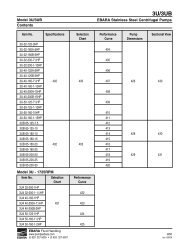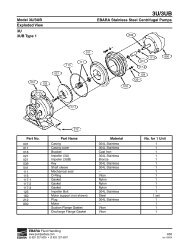Design Manual - International Wastewater Technologies
Design Manual - International Wastewater Technologies
Design Manual - International Wastewater Technologies
You also want an ePaper? Increase the reach of your titles
YUMPU automatically turns print PDFs into web optimized ePapers that Google loves.
13.0 Inspection and Maintenance<br />
13.1 ISOLATOR ROW INSPECTION<br />
Regular inspection and maintenance are essential to assure<br />
a properly functioning stormwater system. Inspec tion is<br />
easily accomplished through the manhole or optional<br />
inspection ports of an Isolator Row. Please follow local<br />
and OSHA rules for a confined space entry.<br />
Inspection ports can allow inspection to be accomplished<br />
completely from the surface without the need for a confined<br />
space entry. Inspection ports provide visual access<br />
to the system with the use of a flashlight. A stadia rod<br />
may be inserted to determine the depth of sediment.<br />
If upon visual inspection it is found that sediment has<br />
accumulated to an average depth exceeding 3" (76 mm),<br />
cleanout is required.<br />
A StormTech Isolator Row should initially be inspected<br />
immediately after completion of the site’s construction.<br />
While every effort should be made to prevent sediment<br />
from entering the system during construction, it is during<br />
this time that excess amounts of sediments are most<br />
likely to enter any stormwater system. Inspection and<br />
maintenance, if necessary, should be performed prior<br />
to passing responsibility over to the site’s owner. Once<br />
in normal service, a StormTech Isolator Row should be<br />
inspected bi-annually until an understanding of the sites<br />
characteristics is developed. The site’s maintenance<br />
manager can then revise the inspection schedule based<br />
on experience or local requirements.<br />
13.2 ISOLATOR ROW MAINTENANCE<br />
JetVac maintenance is recommended if sediment has<br />
been collected to an average depth of 3" (76 mm) inside<br />
the Isolator Row. More frequent maintenance may be<br />
required to maintain minimum flow rates through the<br />
Isolator Row. The JetVac process utilizes a high pressure<br />
water nozzle to propel itself down the Isolator Row while<br />
scouring and suspending sediments. As the nozzle is<br />
retrieved, a wave of suspended sediments is flushed back<br />
into the manhole for vacuuming. Most sewer and pipe<br />
maintenance companies have vacuum/ JetVac combination<br />
vehicles. Fixed nozzles designed for culverts or<br />
large dia meter pipe cleaning are preferable. Rear facing<br />
jets with an effective spread of at least 45" (1143 mm)<br />
are best. The JetVac process shall only be performed<br />
on StormTech Rows that have AASHTO class 1 woven<br />
geotextile over their foundation stone.<br />
Looking down the Isolator Row.<br />
A typical JetVac truck. (This is not a StormTech product.)<br />
Examples of culvert cleaning nozzles appropriate for Isolator Row<br />
maintenance. (These are not StormTech products.)<br />
Call StormTech at 860.529.8188 or 888.892.2694 or visit our website at www.stormtech.com for technical and product information. 21





